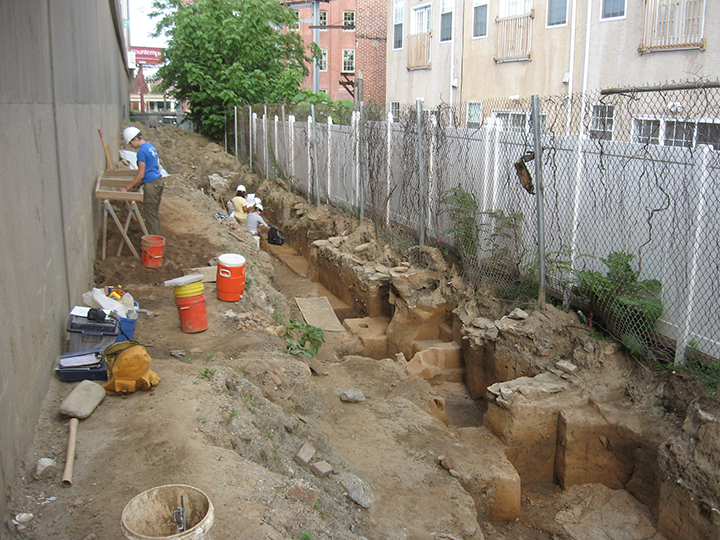Site Page
Remer/Shackamaxon 1

Explore
Remer/Shackamaxon 1:
| Site Name | Remer |
| PASS# | 36PH159 |
| Image | 1 image site overview |
| Dates of Excavation | 2009 |
| Phase of Excavation | Phase I, II, and III |
| Number of Units | 22 |
| Approximate Number of Features Identified | 67 |
| Associated Periods | Pre-contact, eighteenth century and nineteenth century |
| Sire Acreage | 3.69 |
Site History Summary
This domestic site is named for the family that occupied this property in the late 1700s and early 1800s. The first member of the family to reside on the site was Matthew Remer (circa 1758–1804). Matthew’s father, Godfrey, immigrated to Philadelphia from Germany in the early 1750s and eventually settled in the village of Kensington, as this area was known at the time. Godfrey was a butcher by profession and built a house for his growing family on Shackamaxon Street, near the corner of Richmond Street (this property is now underneath I-95).
In 1778, Godfrey purchased an adjoining property—which included the current 1026 parcel—for the newly married Matthew, who moved into a frame house already constructed on the site. A ship carpenter by trade, Matthew served during the Revolutionary War in a militia artillery regiment raised from the men living along the Kensington waterfront.
After Matthew’s death in 1804, the home was passed to his widow, Sarah, and then their children upon her death in the 1820s. By the late 1830s, Matthew and Sarah’s daughter Elizabeth Conver Strawn had become the sole owner of the property after buying out her siblings. Eliza resided in the house at 1026 for brief durations from the 1850s through the 1870s, but usually rented it out to a number of tenants, including a policeman, a comb maker, a cigar maker, and a poultry seller.
What Did the Archaeological Excavation Reveal?
Initial machine excavation revealed that the construction of the adjacent concrete highway abutment had destroyed approximately 90% of the 19.5-x-154-foot property. All that remained of the once-intact backyard was a narrow strip of ground, about 3–4 feet wide, along the northern property boundary. Within this undisturbed strip of backyard, archaeologists found a total of 67 historic features associated with the use and development of the Remer property. They also found an intact historic ground surface that preserved nearly 250 artifacts made and used by Native American peoples between approximately 1200 and 500 B.C.
Of the historic features excavated, 37 were postholes associated with former outbuildings or fences, 20 were trash pits and other types of unknown pits, and 10 were square wood-lined boxes and barrel privies, or outhouses. These barrel and box privies contained large amounts of household trash related to several successive generations of the extended Remer family..
Site Page
Remer/Shackamaxon 1

| Site Name | Remer |
| PASS# | 36PH159 |
| Image | 1 image site overview |
| Dates of Excavation | 2009 |
| Phase of Excavation | Phase I, II, and III |
| Number of Units | 22 |
| Approximate Number of Features Identified | 67 |
| Associated Periods | Pre-contact, eighteenth century and nineteenth century |
| Sire Acreage | 3.69 |
Site History Summary
This domestic site is named for the family that occupied this property in the late 1700s and early 1800s. The first member of the family to reside on the site was Matthew Remer (circa 1758–1804). Matthew’s father, Godfrey, immigrated to Philadelphia from Germany in the early 1750s and eventually settled in the village of Kensington, as this area was known at the time. Godfrey was a butcher by profession and built a house for his growing family on Shackamaxon Street, near the corner of Richmond Street (this property is now underneath I-95).
In 1778, Godfrey purchased an adjoining property—which included the current 1026 parcel—for the newly married Matthew, who moved into a frame house already constructed on the site. A ship carpenter by trade, Matthew served during the Revolutionary War in a militia artillery regiment raised from the men living along the Kensington waterfront.
After Matthew’s death in 1804, the home was passed to his widow, Sarah, and then their children upon her death in the 1820s. By the late 1830s, Matthew and Sarah’s daughter Elizabeth Conver Strawn had become the sole owner of the property after buying out her siblings. Eliza resided in the house at 1026 for brief durations from the 1850s through the 1870s, but usually rented it out to a number of tenants, including a policeman, a comb maker, a cigar maker, and a poultry seller.
What Did the Archaeological Excavation Reveal?
Initial machine excavation revealed that the construction of the adjacent concrete highway abutment had destroyed approximately 90% of the 19.5-x-154-foot property. All that remained of the once-intact backyard was a narrow strip of ground, about 3–4 feet wide, along the northern property boundary. Within this undisturbed strip of backyard, archaeologists found a total of 67 historic features associated with the use and development of the Remer property. They also found an intact historic ground surface that preserved nearly 250 artifacts made and used by Native American peoples between approximately 1200 and 500 B.C.
Of the historic features excavated, 37 were postholes associated with former outbuildings or fences, 20 were trash pits and other types of unknown pits, and 10 were square wood-lined boxes and barrel privies, or outhouses. These barrel and box privies contained large amounts of household trash related to several successive generations of the extended Remer family..